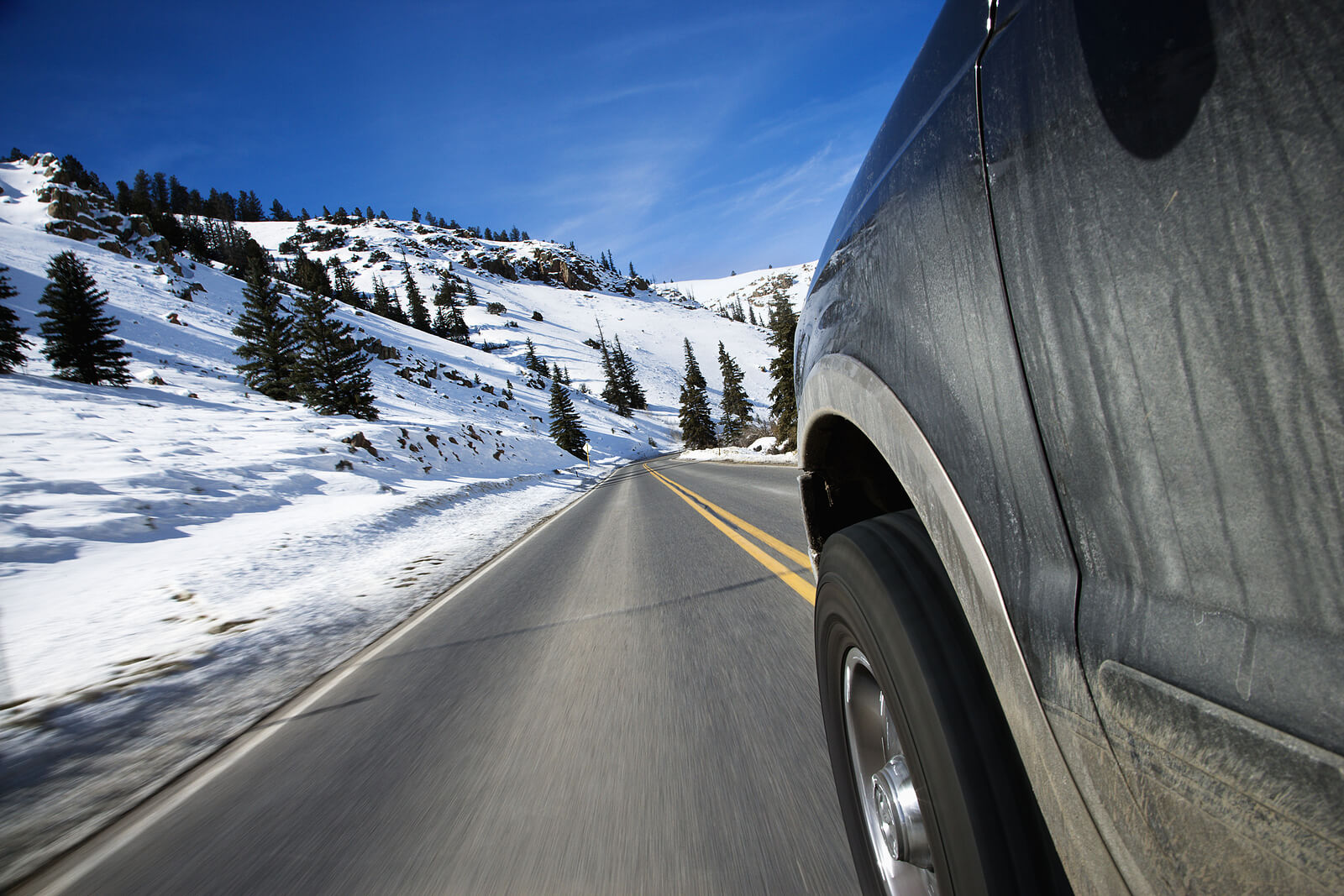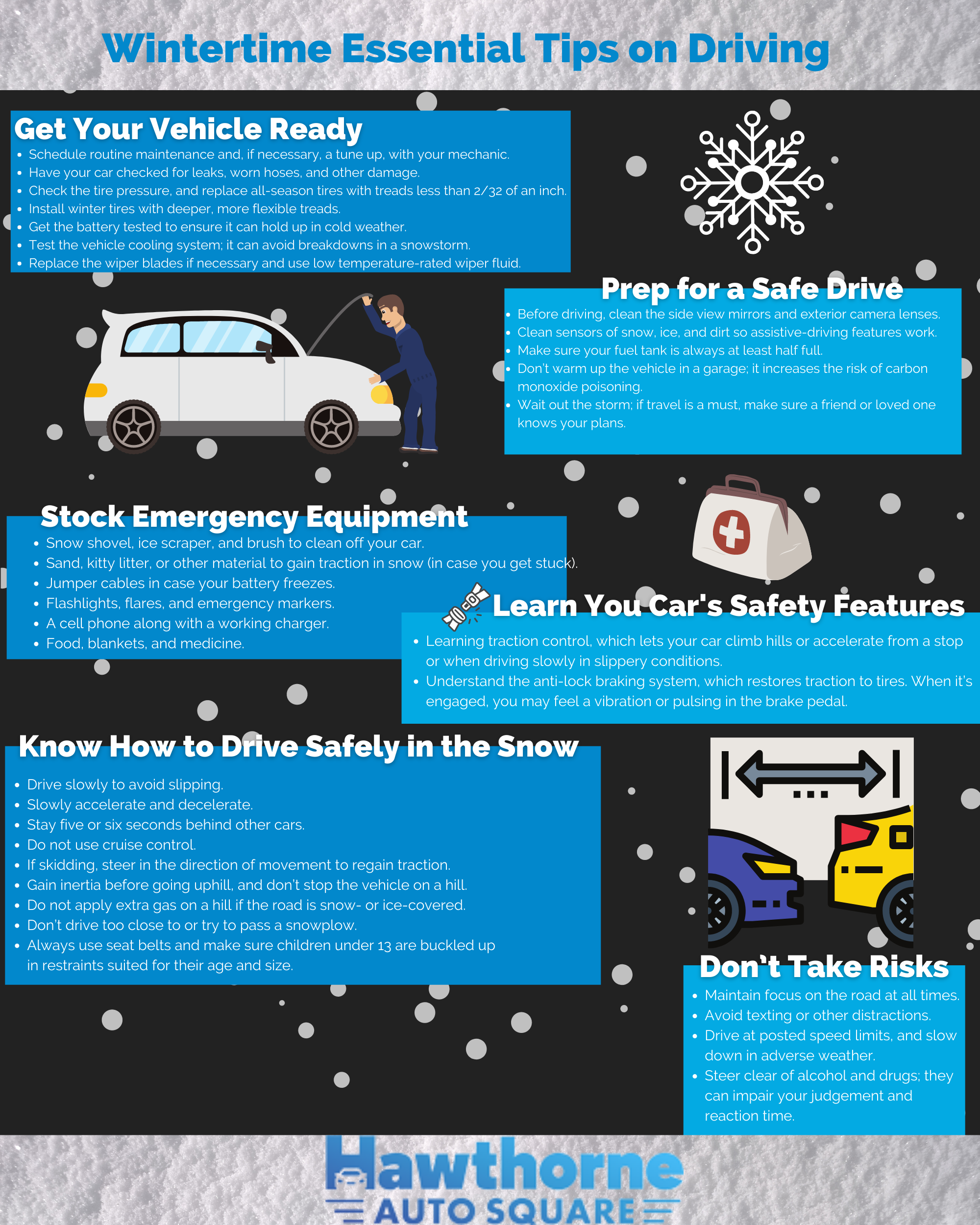
- SALES : (866) 707-7664
- PAYMENTS : (866) 902-7955
- 11646 PRAIRIE AVE, HAWTHORNE, CA 90250
- MON - SAT 8AM - 8PM | SUN 10AM - 6PM
- SALES : (866) 707-7664
- PAYMENTS : (866) 902-7955
- 11646 PRAIRIE AVE, HAWTHORNE, CA 90250
- MON - SAT 8AM - 8PM | SUN 10AM - 6PM
Wintertime Essential Tips on Driving

According to the American Automobile Association, 2,000 people die in road crashes every winter, and about a half million automobile crashes occur during this time, often due to severe weather. Many of the hazards caused by winter storms and poor road conditions can be avoided by following these essential tips on driving.
1. Get Your Vehicle Ready
The first step to improving driving safety in winter is to service your vehicle.
- Schedule routine maintenance and, if necessary, a tune up, with your mechanic.
- Have your car checked for leaks, worn hoses, and other damage.
- Check the tire pressure, and replace all-season tires with treads less than 2/32 of an inch.
- Install winter tires with deeper, more flexible treads.
- Get the battery tested to ensure it can hold up in cold weather.
- Test the vehicle cooling system; it can avoid breakdowns in a snowstorm.
- Replace the wiper blades if necessary and use low temperature-rated wiper fluid.
2. Prepare for a Safe Drive
- Before driving, clean the side view mirrors and exterior camera lenses.
- Clean sensors of snow, ice, and dirt so assistive-driving features work.
- Make sure your fuel tank is always at least half full.
- Don’t warm up the vehicle in a garage; it increases the risk of carbon monoxide poisoning.
- Wait out the storm; if travel is a must, make sure a friend or loved one knows your plans.
3. Stock Your Vehicle with the Proper Items
- Snow shover, ice scraper, and brush to clean off your car.
- Sand, kitty litter, or other material to gain traction in snow (in case you get stuck).
- Jumper cables in case your battery freezes.
- Flashlights, flares, and emergency markers.
- A cell phone along with a working charger.
- Food, blankets, and medicine.
Essential Tips on Driving in the Winter
 4. Get to Know Your Vehicle’s Safety Features
4. Get to Know Your Vehicle’s Safety Features
That includes features like traction control, which lets your car climb hills or accelerate from a stop or when driving slowly in slippery conditions. Also understand the anti-lock braking system, which restores traction to tires. When it’s engaged, you may feel a vibration or pulsing in the brake pedal.
5. Know How to Drive Safely in the Snow
It is best to stay home in bad weather, as it can be harder to control or stop a vehicle on slick roads. But if you must drive in snow or ice:
- Drive slowly to avoid slipping.
- Slowly accelerate and decelerate.
- Stay five or six seconds behind other cars.
- Do not use cruise control.
- If skidding, steer in the direction of movement to regain traction.
- Gain inertia before going uphill, and don’t stop the vehicle on a hill.
- Do not apply extra gas on a hill if the road is snow- or ice-covered.
- Don’t drive too close to or try to pass a snowplow.
- Always use seat belts and make sure children under 13 are buckled up in restraints suited for their age and size.
6. Don’t Take Risk
- Maintain focus on the road at all times.
- Avoid texting or other distractions.
- Drive at posted speed limits, and slow down in adverse weather.
- Steer clear of alcohol and drugs; they can impair your judgement and reaction time.
Are You Shopping for a New Car This Winter?
We hope these tips on driving help you get through the winter safely. If you’re looking for an affordable, high-quality pre-owned vehicle, Hawthorne Auto Square can help. We have numerous sedans, trucks, and SUVs suited for winter travel. We can get you approved for financing in minutes and offer numerous payment options. To learn more and set up an appointment with us, call 866-707-7664 today.
Latest News


Why Should I Buy a Used Toyota Camry?

Bankruptcy and Car Ownership: How BHPH Can Help


Used Car Price Trends for 2025: What Buyers & Sellers Need To Know
Get approved
It only takes a few minutes and won’t affect your credit.
- Pre-Inspected Cars
- Clean Title
- Under Warranty
Latest Videos
What Do I Need To Buy A Car - Hawthorne Auto Square
Second Chance for a New Car - Hawthorne Auto Square
Pre Approved Auto Lone – Hawthorne Auto Square
- SALES : (866) 707-7664
- PAYMENTS : (866) 902-7955
- 11646 PRAIRIE AVE, HAWTHORNE, CA 90250
- MON - SAT 8AM - 8PM | SUN 10AM - 6PM
© 2025 Hawthorne Auto Square. All Rights Reserved. Website Designed by: Ad Leverage | Privacy Policy | Terms of Service | Manage Cookies | DSAR |License #91864
© 2025 Hawthorne Auto Square. All Rights Reserved. Website Designed by:
Ad Leverage | Privacy Policy | Terms of Service
License #91864

